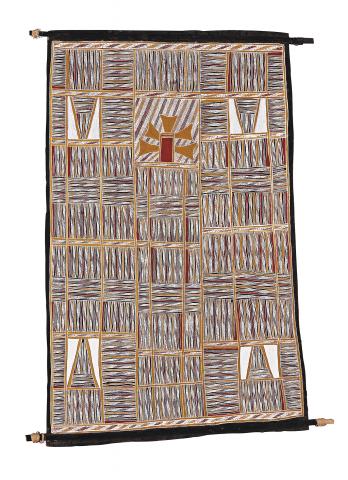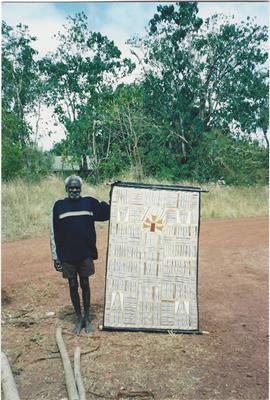WANGURRI AT DHALINGBUY, 2001
MATHULU MUNYARRYUN
natural earth pigments on eucalyptus bark
164.0 x 101.0 cm
bears inscription verso: artist’s name, Buku-Larrngay Mulka Arts cat. 2050E and cat. 0701DHA
Buku-Larrngay Mulka Arts, Yirrkala
The Collection of Colin and Elizabeth Laverty, Sydney, acquired from the above in July 2001
Beyond Sacred: Recent Painting from Australia’s Remote Aboriginal Communities: The Collection of Colin and Elizabeth Laverty, Hardie Grant Books, Melbourne, 2008, p. 304 (illus.)
This work is accompanied by a certificate of authenticity from Buku-Larrngay Mulka Arts that states:
‘Following on a reconciliation between the Djapu and Wangurri clans in June 1999, which coincided with the return of Wonggu’s message sticks by the Governor General, Sir William Deane, there was a great flowering of Wangurri art. This was a relaxation by the elders Mathulu and Bawurr of their normal jealous protection of their miny’tji or clan designs.
This bark painted by Mathulu was produced at Dhalinbuy and brought to Buku-Larrngay Mulka Centre on 26.7.01 which coincided with the visit of Colin and Liz Laverty (long term supporters and collectors of NE Arnhem Land art) who bought the painting in the artist’s presence and with his consent. Mathulu invited the Laverty’s to hear the story of the painting at his homeland of Dhalinbuy as he didn’t wish to reveal it in Yirrkala. They accepted his invitation for a later date.
Mathulu did indicate that the image is one from the freshwater of Dhalinbuy. This allows us to see parallel with images whose icons represent the most sacred of Wangurri ancestral ‘creators’. Logs washed in the freshwaters of Dhalinbuy having travelled from Manggalili sea country. They contained Milka or mangrove worms which died once washed into the fresh water. This pattern was etched in the log and is here repeated as the Wangurri sacred clan design which appears throughout. The songs of the Wangurri invest this log with sacred power allowing it to make paths that other beings and landscape features could follow. The Wangurri can show the head of the log in its feminine shape with the tail of ancestral kingfish Ngoykal, as the Wet Season cumulonimbus on the horizon over Djarrakpi that connects the two clans in a relationship of the others mothers [sic] mother (pregnant with life-giving rain). Stone axe heads are depicted as the central icons.’

